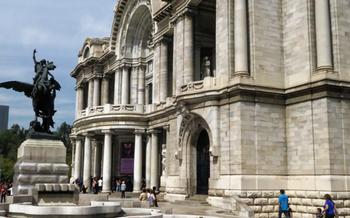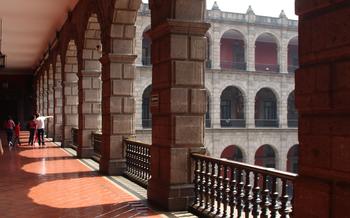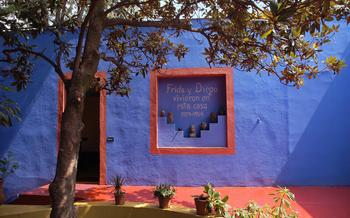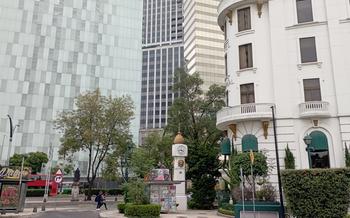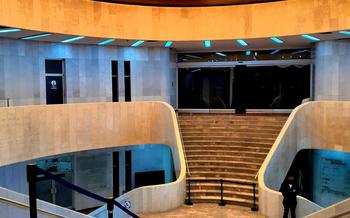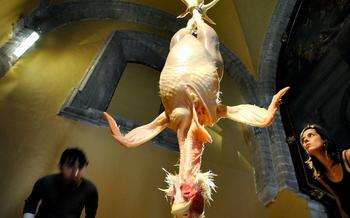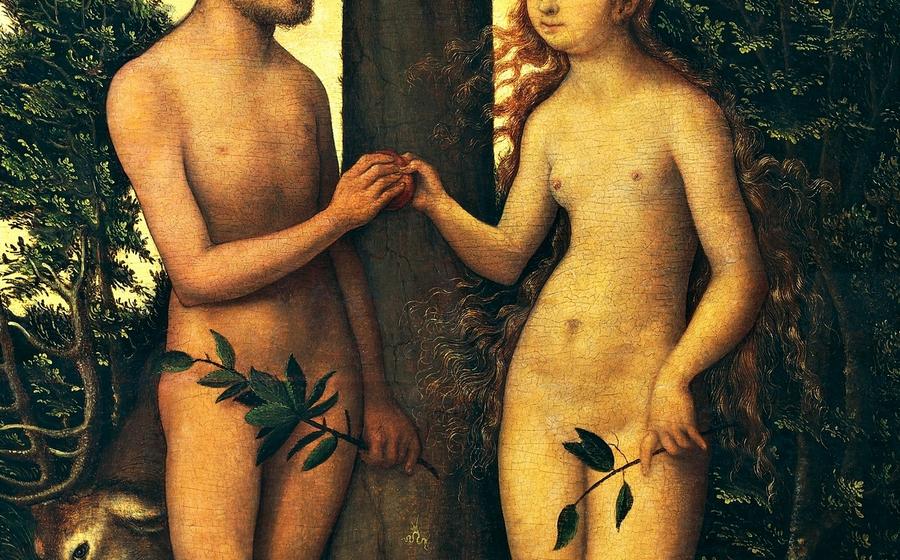
Museo Nacional de San Carlos
- Museo Nacional de San Carlos: An Enchanting Journey into Mexican Art
- Stepping into Art History: A Legacy of Mexican Masters
- A Glimpse into Mexican Culture and Identity
- Admire the Works of Legendary Mexican Artists
- Exploring the European Masters' Influence
- Unveiling the Stories Behind the Art
- A Feast for the Senses: Art, Architecture, and Nature
- Practical Tips for a Rewarding Visit
- Capture the Essence of Mexican Art
- Museo Nacional de San Carlos: A Hidden Gem
- Art for Everyone: Accessibility and Inclusivity
- The Museum's Role in the Community
- Future Visions: The Museum's Ongoing Evolution
- Insider Tip: A Unique Perspective
Museo Nacional de San Carlos: An Enchanting Journey into Mexican Art
Nestled in the heart of Mexico City, the Museo Nacional de San Carlos stands as a testament to the rich artistic heritage of Mexico. Housed in a majestic 18th-century palace, this museum offers visitors a captivating journey through the evolution of Mexican art, from its colonial roots to the vibrant contemporary scene.
The Museo Nacional de San Carlos holds a significant place in Mexican history. It was founded in 1968 as the National Museum of Art and later renamed in honor of the renowned Mexican artist San Carlos. Over the years, the museum has become a repository of invaluable artworks that reflect the nation's cultural identity and artistic prowess.
The architectural beauty of the museum building itself is a sight to behold. Its neoclassical facade and elegant interiors create a fitting backdrop for the stunning collection within. The spacious galleries, adorned with intricate moldings and high ceilings, provide an ideal setting to showcase the masterpieces of Mexican art.
The highlights of the collection include works by some of the most celebrated Mexican artists, such as Diego Rivera, José Clemente Orozco, David Alfaro Siqueiros, and Frida Kahlo. Visitors can marvel at Rivera's powerful murals, Orozco's poignant social commentaries, Siqueiros' dynamic compositions, and Kahlo's deeply personal and symbolic paintings.
The museum offers a variety of visitor information to enhance the experience. Opening hours are Tuesday to Sunday from 10:00 AM to 5:00 PM. Admission fees are minimal, and guided tours are available in English and Spanish. The museum also provides educational programs and workshops for all ages, making it a great destination for families and art enthusiasts alike.
Stepping into Art History: A Legacy of Mexican Masters
The Museo Nacional de San Carlos is a repository of Mexican art history, showcasing the evolution of artistic expression in Mexico from the colonial era to contemporary times. European influence played a significant role in shaping Mexican art, with the arrival of Spanish conquistadors bringing European artistic techniques and styles. Over time, Mexican artists assimilated these influences, blending them with indigenous traditions to create a unique and distinctly Mexican style.
The museum's collection boasts representative works by legendary Mexican artists, offering a comprehensive overview of the country's artistic heritage. From Diego Rivera's powerful murals to José Clemente Orozco's poignant social commentaries, and David Alfaro Siqueiros' dynamic compositions, the museum presents a panorama of Mexican art's most influential figures. These masterpieces not only showcase the artistic brilliance of these masters but also provide a glimpse into Mexico's rich history, social struggles, and cultural identity.
The Museo Nacional de San Carlos stands as a testament to the enduring legacy of Mexican art, preserving and showcasing the works of the nation's most celebrated artists. Through its diverse collection, the museum not only educates and inspires visitors but also contributes to the preservation and promotion of Mexico's cultural heritage.
A Glimpse into Mexican Culture and Identity
In the heart of Mexico City, the Museo Nacional de San Carlos stands as a testament to the rich cultural heritage of Mexico. Here, visitors can immerse themselves in a captivating journey through Mexican art, which serves as a mirror reflecting the nation's history, social struggles, and profound sense of identity.
Art in Mexico is not merely a form of aesthetic expression; it is a vibrant force that courses through the veins of the nation's soul. From pre-Columbian times to the present day, artists have used their canvases and sculptures to narrate the story of Mexico, capturing the essence of its people, their triumphs, and their tribulations.
The Museo Nacional de San Carlos proudly showcases this artistic legacy, presenting a diverse collection that spans centuries and styles. Through these artworks, visitors can trace the evolution of Mexican identity, from the ancient indigenous civilizations to the colonial era and the vibrant modern period.
One of the most striking aspects of Mexican art is its deep connection to the nation's indigenous heritage. From the intricate designs of pre-Columbian pottery to the vibrant colors and motifs of contemporary folk art, indigenous influences permeate the Mexican artistic landscape. This rich cultural tapestry is celebrated and preserved within the walls of the Museo Nacional de San Carlos, where visitors can admire the enduring legacy of Mexico's diverse indigenous communities.
The museum also sheds light on the social and political issues that have shaped Mexico's history. Through powerful murals and thought-provoking paintings, artists have addressed themes such as poverty, inequality, and the struggle for social justice. These works offer a poignant commentary on the challenges faced by the Mexican people, inviting visitors to reflect on the nation's past and present.
The Museo Nacional de San Carlos is more than just a repository of art; it is a symbol of national pride and identity. Here, visitors can gain a profound understanding of the Mexican soul, its complexities, its resilience, and its unwavering spirit. Through its diverse collection, the museum invites visitors to celebrate the rich cultural heritage of Mexico and to appreciate the profound significance of art in shaping a nation's identity.
Admire the Works of Legendary Mexican Artists
The Museo Nacional de San Carlos is home to an impressive collection of works by some of Mexico's most renowned artists. Diego Rivera's powerful murals, José Clemente Orozco's poignant social commentaries, David Alfaro Siqueiros' dynamic compositions, and Frida Kahlo's deeply personal and symbolic paintings are among the highlights of the museum.
Rivera's murals, such as "The Creation" and "The History of Mexico," are characterized by their monumental scale, vibrant colors, and intricate symbolism. Orozco's works, such as "The Trench" and "The Zapatistas," offer a powerful critique of social injustice and political oppression. Siqueiros' dynamic compositions, such as "The March of Humanity" and "The Birth of Fascism," are known for their use of bold colors, geometric shapes, and innovative techniques.
Kahlo's deeply personal and symbolic paintings, such as "Self-Portrait with Thorn Necklace and Hummingbird" and "The Wounded Deer," explore themes of identity, pain, and love. These iconic works offer a glimpse into the artist's tumultuous life and her unique perspective on the human condition.
Exploring the European Masters' Influence
The Museo Nacional de San Carlos also boasts a remarkable collection of European paintings from the 16th to the 19th centuries. Here, visitors can admire works of art from renowned Spanish, Italian, Flemish, and French masters. These works provide a valuable context for understanding the evolution of Mexican art, as they showcase the artistic influences and techniques that were adopted and adapted by Mexican artists.
Comparing the European and Mexican works on display, one can observe striking similarities and differences in style, subject matter, and technique. The European paintings often depict religious or mythological scenes, rendered with meticulous detail and vibrant colors. In contrast, Mexican art often portrays historical events, social issues, and indigenous traditions, using bold colors and dynamic compositions.
The museum's collection of European art not only enriches the visitor's understanding of Mexican art but also fosters cultural exchange and dialogue. It highlights the interconnectedness of the global art world and demonstrates how artistic ideas and styles travel and evolve across borders.
Unveiling the Stories Behind the Art
The Museo Nacional de San Carlos offers a variety of ways for visitors to delve deeper into the stories behind the artworks. Guided tours led by knowledgeable experts provide insights into the artists' techniques, inspirations, and the historical and cultural context of their creations. Interactive exhibits and multimedia displays bring the artworks to life, allowing visitors to explore them in new and engaging ways. Educational programs and workshops for all ages encourage hands-on learning and foster a deeper appreciation for Mexican art. Through these initiatives, the museum serves as a hub for learning and cultural engagement, inviting visitors to explore the rich tapestry of Mexican art and its significance in shaping the nation's identity.
A Feast for the Senses: Art, Architecture, and Nature
Beyond its impressive collection, the Museo Nacional de San Carlos captivates visitors with its stunning architecture and serene surroundings. The building itself is a masterpiece of Neoclassical design, featuring elegant columns, intricate carvings, and a grand entrance that sets the tone for the artistic journey within.
As you wander through the galleries, take a moment to admire the harmonious blend of art, architecture, and nature. The natural light that filters through the windows illuminates the artworks, creating a magical interplay of light and shadow. The surrounding gardens, with their lush greenery and colorful blooms, provide a tranquil oasis where you can pause and reflect on the beauty you've encountered.
The Museo Nacional de San Carlos is a place where the senses are awakened and the mind is inspired. It offers a multi-sensory experience that goes beyond traditional museum visits, inviting you to immerse yourself in the richness of Mexican art and culture.
Practical Tips for a Rewarding Visit
To make the most of your visit to the Museo Nacional de San Carlos, it's essential to plan ahead. Check the museum's website for information on temporary exhibitions and special events. Take advantage of the museum's free admission hours, typically on Sundays, to save on entrance fees. To enhance your understanding of the artworks, consider renting an audio guide, available in multiple languages.
Allow yourself ample time to explore the museum's vast collection thoroughly. Avoid rushing through the galleries; take your time to appreciate each piece, read the descriptions, and contemplate the artist's message. If you have any questions or need assistance during your visit, don't hesitate to approach the friendly museum staff, who are always willing to help.
Capture the Essence of Mexican Art
The Museo Nacional de San Carlos encourages visitors to capture the essence of Mexican art through photography. Most areas of the museum allow photography, providing an opportunity to document and share the beauty of the artworks. Visitors are encouraged to share their photos on social media using hashtags like #MuseoNacionaldeSanCarlos and #MexicoCityArt, helping to promote the museum and its collection to a wider audience. By sharing their experiences and favorite pieces, visitors become ambassadors of Mexican art, contributing to its appreciation and recognition both nationally and internationally.
Museo Nacional de San Carlos: A Hidden Gem
Despite its rich collection and historical significance, the Museo Nacional de San Carlos remains a hidden gem compared to other popular attractions in Mexico City. This presents a unique opportunity for visitors to avoid the crowds and have a more intimate experience with Mexican art. The museum's relatively low profile also allows visitors to discover and appreciate lesser-known Mexican artists, whose works may be overshadowed by the more famous names. The Museo Nacional de San Carlos offers a chance for quiet contemplation and reflection, allowing visitors to immerse themselves in the beauty and depth of Mexican art without the distractions of large crowds.
Art for Everyone: Accessibility and Inclusivity
The Museo Nacional de San Carlos is committed to making art accessible to everyone, regardless of physical abilities or cultural background. The museum is wheelchair accessible, with ramps and elevators throughout the building. Visitors with disabilities can also borrow wheelchairs from the museum's front desk. The museum offers educational programs and resources for children and families, including guided tours and interactive exhibits. Guided tours are available in different languages for international visitors, ensuring that everyone can understand and appreciate the museum's collection. The museum's commitment to inclusivity is evident in its efforts to make art accessible to all, fostering a welcoming and educational environment for all visitors.
The Museum's Role in the Community
The Museo Nacional de San Carlos is not just a repository of art but also an active participant in the cultural and social development of Mexico City. Through its educational and outreach programs, the museum strives to make art accessible to all segments of the population, regardless of age, background, or ability.
The museum collaborates with local schools and community organizations to provide art education and appreciation programs for children and families. Guided tours in different languages cater to international visitors, ensuring that the museum's treasures are shared with a global audience.
The Museo Nacional de San Carlos is more than just a museum; it is a catalyst for social and cultural development. It plays a vital role in promoting art education, fostering cultural dialogue, and strengthening community bonds. Through its diverse programs and initiatives, the museum contributes to the vibrant cultural landscape of Mexico City and enriches the lives of its citizens.
Future Visions: The Museum's Ongoing Evolution
The Museo Nacional de San Carlos is not resting on its laurels; it is continuously striving to improve and evolve. Plans are underway for a significant expansion and renovation project that will enhance the museum's facilities and provide more space for exhibitions and educational programs. The museum is also committed to staying relevant and dynamic, with new initiatives to engage with diverse audiences. This includes outreach programs for schools and community organizations, as well as guided tours in different languages for international visitors. The Museo Nacional de San Carlos is dedicated to ensuring that it remains a vibrant and vital part of Mexico City's cultural landscape, continuing to inspire and educate visitors for generations to come.
Insider Tip: A Unique Perspective
To fully immerse yourself in the beauty and tranquility of the Museo Nacional de San Carlos, consider visiting on a weekday morning. This will allow you to avoid the weekend crowds and have a more intimate experience with the artworks. Begin your journey with the European collection, appreciating the contrast between the styles and techniques of European masters and Mexican artists. Take a break in the serene garden, surrounded by lush greenery and vibrant flowers, to soak in the tranquility and reflect on the artworks you've encountered. Conclude your visit with a coffee and a light snack at the museum's charming café, allowing the memories of your artistic journey to linger as you bid farewell to this hidden gem.
